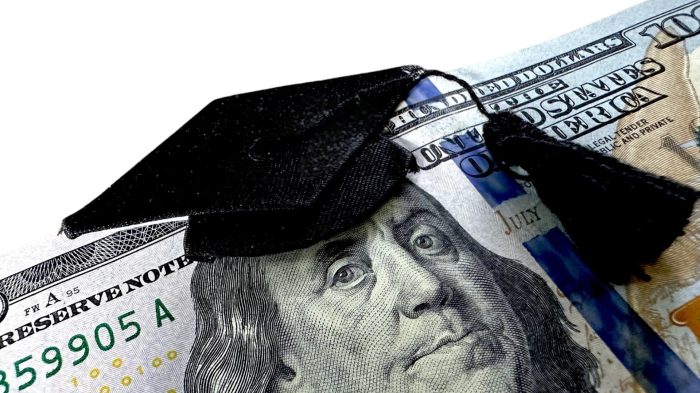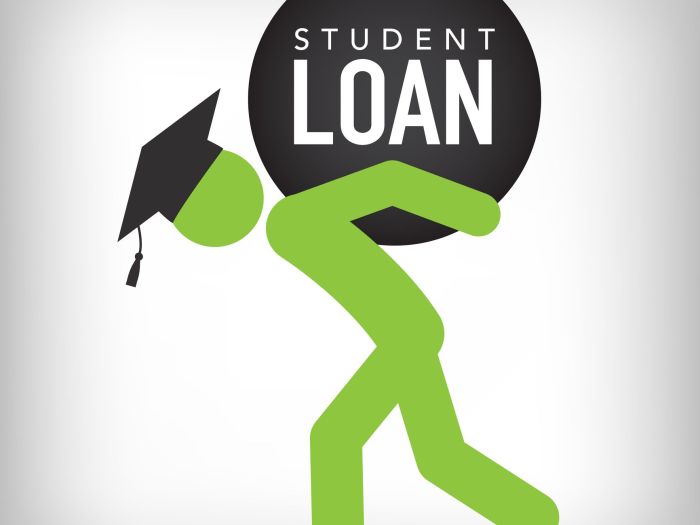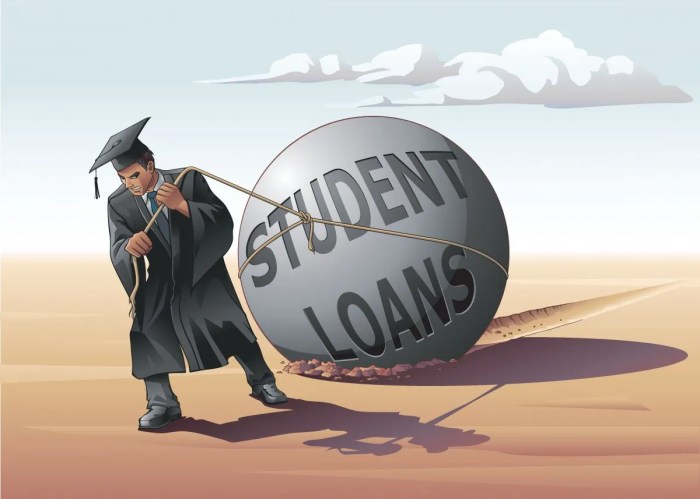
The pursuit of higher education often hinges on the availability of funding, and for many, government student loan programs are the key that unlocks academic opportunities. This guide delves into the intricacies of these programs, exploring the various options available, their eligibility requirements, repayment plans, and the broader impact on students’ financial futures. We’ll unravel the complexities, offering a clear understanding of the benefits and potential drawbacks to help you make informed decisions.
From understanding different loan types and forgiveness programs to navigating repayment strategies and appreciating the government’s role in regulating the lending process, we aim to equip you with the knowledge necessary to confidently manage your student loan journey. This comprehensive overview will empower you to make the best choices for your educational and financial well-being.
Government Student Loan Programs

Navigating the world of student loans can be daunting, but understanding the different government programs available can significantly simplify the process. This section provides an overview of various government student loan programs, outlining eligibility requirements, repayment options, and key differences. It is crucial to carefully consider each program’s features to determine the best fit for your individual circumstances.
Types of Government Student Loan Programs
The United States government offers several federal student loan programs designed to help students finance their education. These programs differ in their eligibility requirements, interest rates, and repayment plans. Understanding these differences is key to making informed borrowing decisions. The main programs include Federal Direct Subsidized Loans, Federal Direct Unsubsidized Loans, and Federal Direct PLUS Loans.
Eligibility Criteria for Government Student Loan Programs
Eligibility for each federal student loan program varies. Generally, students must be enrolled at least half-time in an eligible degree or certificate program at a participating institution. They must also demonstrate financial need for subsidized loans, while unsubsidized loans have no need-based requirement. PLUS loans are available to parents of dependent students and graduate students, and credit history is a factor in approval. Specific requirements and documentation may vary depending on the program and the lender.
Repayment Options for Government Student Loan Programs
Federal student loans offer several repayment options to accommodate borrowers’ financial situations. These options include standard repayment, extended repayment, graduated repayment, and income-driven repayment plans. Standard repayment involves fixed monthly payments over a 10-year period. Extended repayment offers longer repayment terms, reducing monthly payments but increasing the total interest paid. Graduated repayment starts with lower monthly payments that increase over time. Income-driven repayment plans tie monthly payments to a percentage of the borrower’s discretionary income. Choosing the right repayment plan depends on individual financial circumstances and long-term goals.
Comparison of Government Student Loan Programs
The following table compares three major federal student loan programs: Federal Direct Subsidized Loans, Federal Direct Unsubsidized Loans, and Federal Direct PLUS Loans. Note that interest rates are subject to change annually. The information provided here is for illustrative purposes and should not be considered financial advice. Always refer to the official government website for the most up-to-date information.
| Loan Program | Interest Rate (Example – Subject to Change) | Maximum Loan Amount (Example – Subject to Change) | Repayment Terms (Example) |
|---|---|---|---|
| Federal Direct Subsidized Loan | Variable, dependent on loan disbursement date | Varies by year and school, determined by financial need and cost of attendance | 10-25 years depending on repayment plan |
| Federal Direct Unsubsidized Loan | Variable, dependent on loan disbursement date | Varies by year and school, independent of financial need | 10-25 years depending on repayment plan |
| Federal Direct PLUS Loan | Variable, dependent on loan disbursement date | Cost of attendance minus other financial aid | 10-25 years depending on repayment plan |
Student Loan Forgiveness Programs

Student loan forgiveness programs offer the possibility of eliminating a portion or all of your student loan debt under specific circumstances. These programs are designed to alleviate the burden of student loan repayment for individuals who meet particular criteria, often related to public service, specific career paths, or economic hardship. However, it’s crucial to understand the eligibility requirements, limitations, and potential drawbacks before relying on these programs for debt relief.
Public Service Loan Forgiveness (PSLF) Program
The Public Service Loan Forgiveness (PSLF) Program forgives the remaining balance on your Direct Loans after you have made 120 qualifying monthly payments under a qualifying repayment plan while working full-time for a qualifying employer. Qualifying employers include government organizations at the federal, state, local, or tribal level, and not-for-profit organizations.
- Requirement: 120 qualifying monthly payments under an income-driven repayment plan while employed full-time by a qualifying employer.
- Limitation: Only Direct Loans are eligible. Consolidation of Federal Family Education Loans (FFEL) into Direct Consolidation Loans is possible, but the consolidation must occur before making payments towards forgiveness. There are strict guidelines on what constitutes a “qualifying payment” and employment.
- Benefits: Complete forgiveness of remaining loan balance after 10 years of qualifying payments.
- Drawbacks: The program has historically had a low success rate due to stringent requirements and administrative complexities. It requires consistent employment and payment adherence for a decade.
Teacher Loan Forgiveness Program
This program offers forgiveness of up to $17,500 on eligible federal student loans for teachers who have completed five complete and consecutive academic years of full-time teaching in a low-income school or educational service agency.
- Requirement: Five consecutive years of full-time teaching at a low-income school or educational service agency. The school must be designated as a low-income school by the U.S. Department of Education.
- Limitation: Only certain federal student loans are eligible, and the forgiveness amount is capped at $17,500.
- Benefits: Significant reduction in student loan debt for qualifying teachers.
- Drawbacks: Strict requirements regarding school type and teaching duration. The forgiveness amount may not cover the entire loan balance for some individuals.
Income-Driven Repayment (IDR) Plans
While not strictly forgiveness programs, Income-Driven Repayment (IDR) plans can lead to loan forgiveness after 20 or 25 years of payments, depending on the plan. These plans calculate your monthly payments based on your income and family size. Any remaining balance after the set period is forgiven. However, this forgiven amount is considered taxable income.
- Requirement: Consistent payments under a qualifying IDR plan for 20 or 25 years.
- Limitation: Forgiven amount is considered taxable income, potentially leading to a significant tax liability.
- Benefits: More manageable monthly payments, leading to eventual loan forgiveness.
- Drawbacks: Forgiveness is delayed for a long period (20 or 25 years), and the forgiven amount is taxable income.
The Impact of Government Student Loans on Students

Government student loan programs have profoundly impacted higher education access and the financial trajectories of millions. While these loans offer crucial opportunities, they also present significant challenges, shaping the experiences and long-term financial well-being of students in diverse ways. Understanding both the positive and negative aspects is crucial for informed decision-making.
Increased Access to Higher Education
Government student loans have dramatically expanded access to higher education for students from lower-income backgrounds and those who would otherwise be unable to afford tuition, fees, and living expenses. The availability of these loans allows individuals to pursue educational opportunities that might otherwise be unattainable, leading to increased social mobility and a more diverse student population in colleges and universities. For example, Pell Grants, a type of federal need-based grant, combined with federal student loans, enable many low-income students to attend college who would not otherwise be able to do so. This has demonstrably broadened participation in higher education, resulting in a more skilled and educated workforce.
The Burden of Student Loan Debt
The substantial accumulation of student loan debt represents a significant challenge for many graduates. High levels of debt can delay major life decisions such as homeownership, starting a family, and investing in retirement. The weight of repayment can lead to significant financial stress and limit career choices, as graduates may prioritize higher-paying jobs over those that align with their passions or values. For instance, a graduate with $100,000 in student loan debt might find themselves choosing a higher-paying but less fulfilling job in finance over a lower-paying position in the arts, despite their artistic aspirations. This can have long-term implications for personal satisfaction and overall well-being.
Comparison of Student Experiences
Students who utilize government loans often experience a different post-graduate financial landscape compared to their peers who finance their education through other means, such as savings, family support, or scholarships. Those with significant loan debt frequently face tighter budgets, more limited financial flexibility, and a longer period of financial recovery after graduation. In contrast, students who avoid substantial debt often enjoy greater financial freedom and can more easily pursue personal and professional goals without the constraints of loan repayments. The difference in these experiences can be substantial, influencing career choices, lifestyle decisions, and overall financial stability.
Long-Term Financial Implications of Student Loan Debt
The long-term financial implications of student loan debt can be far-reaching. High levels of debt can negatively impact credit scores, making it more difficult to secure loans for mortgages, car purchases, or business ventures. It can also lead to delayed retirement savings and reduced wealth accumulation over a lifetime. For example, a graduate burdened with significant debt may postpone saving for retirement, resulting in a smaller nest egg and a potentially less comfortable retirement. Furthermore, the interest accrued on student loans can substantially increase the total amount owed, compounding the financial burden over time. This underscores the importance of responsible borrowing and diligent financial planning during and after college.
Government Student Loan Repayment Plans
Navigating the complexities of student loan repayment can be daunting. Understanding the various repayment plans available is crucial for effective financial management and avoiding potential pitfalls. The federal government offers several options, each with its own set of benefits and drawbacks, designed to cater to different financial situations and repayment preferences. Choosing the right plan significantly impacts your monthly payments and overall repayment timeline.
Standard Repayment Plan
The Standard Repayment Plan is the default plan for most federal student loan borrowers. It involves fixed monthly payments over a 10-year period. This plan offers simplicity and predictability, making it a popular choice for many borrowers.
- Advantage: Predictable monthly payments and a relatively short repayment period.
- Disadvantage: Higher monthly payments compared to income-driven repayment plans. May be challenging for borrowers with limited income immediately after graduation.
Graduated Repayment Plan
Under the Graduated Repayment Plan, monthly payments start low and gradually increase over time. This plan is designed to ease the burden of repayment in the early years, when income is typically lower.
- Advantage: Lower initial monthly payments, making it more manageable in the early stages of repayment.
- Disadvantage: Payments significantly increase over time, potentially becoming unaffordable later in the repayment period. The total repayment period is also 10 years.
Extended Repayment Plan
The Extended Repayment Plan stretches your repayment period to up to 25 years. This plan lowers your monthly payment significantly but increases the total interest paid over the life of the loan.
- Advantage: Significantly lower monthly payments compared to other plans.
- Disadvantage: Substantially higher total interest paid over the repayment period. A longer repayment period extends the time it takes to become debt-free.
Income-Driven Repayment Plans
Income-driven repayment plans (IDRs) tie your monthly payment to your income and family size. These plans are designed to make repayment more manageable for borrowers with lower incomes. Several types of IDR plans exist, including Income-Based Repayment (IBR), Pay As You Earn (PAYE), Revised Pay As You Earn (REPAYE), and Income-Contingent Repayment (ICR). Each plan has slightly different eligibility requirements and payment calculation formulas.
- Advantage: Lower monthly payments based on your income, making repayment more affordable. Potential for loan forgiveness after 20 or 25 years, depending on the plan.
- Disadvantage: Longer repayment periods (potentially 20-25 years), leading to higher total interest paid over the life of the loan. Complex application processes and income verification requirements.
Selecting a Repayment Plan: A Flowchart
A flowchart would visually represent the decision-making process. It would begin with a question about the borrower’s income and financial situation. Branches would lead to different plans based on the answers: High income/strong financial situation leading to Standard or Graduated plans; lower income/weaker financial situation leading to an IDR plan. Another branch would consider the borrower’s preference for lower monthly payments versus a shorter repayment period. The flowchart would ultimately direct the borrower to the most suitable repayment plan based on their individual circumstances.
Calculating Monthly Payments: Hypothetical Examples
Let’s assume a hypothetical loan of $30,000 with a 6% interest rate.
Standard Repayment (10 years): Monthly payment would be approximately $330. Total interest paid would be approximately $9,600.
Extended Repayment (25 years): Monthly payment would be approximately $160. Total interest paid would be significantly higher, approximately $29,000.
Note: These are simplified examples. Actual monthly payments depend on factors such as loan amount, interest rate, and loan type. The use of a loan repayment calculator provided by the federal government or a reputable financial institution is highly recommended for accurate calculations.
The Role of Government in Student Loan Management
The government plays a multifaceted role in the student loan system, acting as a regulator, protector, and facilitator. Its involvement extends from establishing lending standards to ensuring borrowers receive fair treatment and have access to manageable repayment options. This crucial oversight aims to balance the need for accessible higher education with the prevention of predatory lending practices and the responsible management of taxpayer funds.
Government Regulation of Student Loan Lenders
The government, primarily through agencies like the Department of Education in the United States, establishes and enforces regulations governing student loan lenders. These regulations cover various aspects, including lender eligibility, loan terms and conditions, and servicing standards. Compliance is crucial for lenders participating in government-backed loan programs. For instance, regulations might specify maximum interest rates, prohibit deceptive marketing practices, and mandate clear disclosure of loan terms. Regular audits and investigations help ensure lenders adhere to these rules. Failure to comply can result in significant penalties, including fines and the loss of eligibility to participate in government programs.
Protecting Students from Predatory Lending Practices
Government intervention is vital in shielding students from predatory lending. Predatory practices, such as high-interest rates, hidden fees, and aggressive collection tactics, can trap borrowers in a cycle of debt. Government regulations aim to curb these practices by setting limits on interest rates for federal loans, mandating clear and concise disclosure of all loan terms, and providing avenues for borrowers to report and challenge unfair lending practices. Consumer protection agencies also play a role in educating students about their rights and providing resources for resolving disputes with lenders. For example, the establishment of robust complaint mechanisms and consumer protection bureaus allows for effective redressal of grievances.
Government Initiatives for Improved Student Loan Accessibility and Affordability
Numerous government initiatives focus on making student loans more accessible and affordable. These include programs offering grants and scholarships, subsidized loans with lower interest rates, and income-driven repayment plans. Examples include the Pell Grant program in the US, which provides need-based grants to undergraduate students, and various income-driven repayment plans that adjust monthly payments based on the borrower’s income and family size. Furthermore, initiatives promoting financial literacy among students help them make informed borrowing decisions and manage their debt effectively. These efforts aim to ensure that the cost of higher education does not disproportionately burden students from low-income backgrounds.
Visual Representation of Government Involvement in the Student Loan Lifecycle
Imagine a flowchart. The process begins with the “Application Stage,” where the government’s role is to regulate eligibility criteria and lender participation. Next is the “Loan Approval Stage,” with the government ensuring fair lending practices and setting interest rate limits. Then comes the “Disbursement Stage,” where the government monitors the funds’ distribution to students and institutions. The “Repayment Stage” shows the government’s role in overseeing repayment plans, providing options like income-driven repayment, and managing loan forgiveness programs. Finally, “Default Management” depicts the government’s involvement in addressing loan defaults and offering rehabilitation programs. Each stage is interconnected, illustrating the government’s continuous oversight throughout the entire loan lifecycle. This comprehensive approach ensures fair access, responsible lending, and manageable repayment for students.
Closure
Securing a higher education shouldn’t be a financial burden that overshadows academic achievement. By understanding the nuances of government student loan programs, including eligibility criteria, repayment options, and forgiveness opportunities, students can approach their educational pursuits with greater confidence and financial clarity. This guide serves as a starting point, encouraging further research and personalized planning to ensure a successful and sustainable path toward academic and financial success. Remember to explore all available resources and seek professional advice when needed.
FAQ Explained
What happens if I can’t make my student loan payments?
Contact your loan servicer immediately. They can help you explore options like deferment, forbearance, or income-driven repayment plans to avoid default.
Are there any penalties for paying off student loans early?
Generally, no. Prepaying your student loans usually doesn’t incur penalties, and can save you money on interest in the long run.
How do I consolidate my student loans?
You can consolidate federal student loans through the Department of Education’s website. This combines multiple loans into a single loan with a new repayment plan.
What is the difference between subsidized and unsubsidized loans?
Subsidized loans don’t accrue interest while you’re in school (under certain conditions), whereas unsubsidized loans accrue interest from the time the loan is disbursed.
